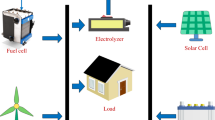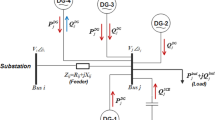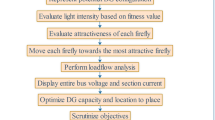Abstract
This paper presents the investigation of distributed generation (DG) penetration limits of a distribution network (DN) using multi-objective particle swarm optimization (MOPSO) technique with the aim of finding the optimal location and size of DGs suitable for the distribution system to effectively reduce power losses and improve voltage profile. For the purpose of experimentation, the Harar Town distribution system (HTDS) at Harar town in Ethiopia was taken as a case study. To deliver the required power demand of the DN at HTDS, HTDS requires optimal planning to achieve minimum power loss and voltage deviation when installing distributed generation with proper penetration limits using MOSPO. For the problem formulation, the objective functions used for the MOPSO technique which are to be minimized are the total active power loss, reactive power loss (QL), and total voltage deviation (± 0.05%) for the 15 kV distribution feeder. MOPSO is employed to solve the problem with the aim of meeting the IEEE standards. The results show that the existing DN is not able to meet the future demand due to its voltage deviation (VD) and high power losses. As a result, distributed generation upgrade planning was carried out using MOPSO, taking into account the future growth and DG deployments, as well as penetration restrictions of the distribution system. The MOPSO technique was used to reduce the total power loss as well as the VD of the system. The Harar city distribution system of East Harergie, Ethiopia was used to show the dominance of the proposed technique. The study aimed to minimize power loss on an IEEE 33-bus test system using various case scenarios in MATLAB optimization toolbox in MATLAB programing environment. The results show that when DG is added to the system, it achieves a 10% penetration rate, which is better than the base case scenario. The system is optimized when it reaches 40% (it is optimized and its range is within the IEEE standard). The results further show that the overall actual power loss (PL) without DG is 368.879 kW, while the total real PL with DG is 67.26 kW, indicating a considerable difference between the two scenarios (a reduction of 81.77%).












Similar content being viewed by others
References
Partha K, Chanda CK (2013) A simple and fast approach for allocation and size evaluation of distributed generation. Int J Energy Environ Eng 4(1):1–9. https://doi.org/10.1186/2251-6832-4-7
Nweke JN, Salau AO, Eya CU (2022) Headroom-based optimization for placement of distributed generation in a distribution substation. Eng Rev 42(1):1–10. https://doi.org/10.30765/er.1748
Agajie TF, Salau AO, Hailu EA, Awoke YA (2020) Power loss mitigation and voltage profile improvement with distributed generation using grid-based multi-objective harmony search algorithm. J Electr Electron Eng 13(2):5–10
Ameli A, Bahrami S, Khazaeli F, Haghifam M-R (2014) A multi objective particle swarm optimization for sizing and placement of DGs from DG owner’s and distribution company’s viewpoints. IEEE Trans Power Deliv 29(4):1–10
Villalobos JG, Zamora I, Knezović K, Marinelli M (2016) Multi-objective optimization control of plug-in electric vehicles in low voltage distribution networks. Appl Energy 180:155–168. https://doi.org/10.1016/j.apenergy.2016.07.110
Salau AO, Nweke J, Ogbuefi U (2021) Effective implementation of mitigation measures against voltage collapse in distribution power systems. Przeglad Elektrotechniczny. https://doi.org/10.15199/48.2021.10.13
Addisu M, Salau AO, Takele H (2021) Fuzzy logic based optimal placement of voltage regulators and capacitors for distribution systems efficiency improvement. Heliyon 7(8):e07848. https://doi.org/10.1016/j.heliyon.2021.e07848
Bahrami S, Amini MH (2017) A decentralized framework for real-time energy trading in distribution networks with load and generation uncertainty. arXiv preprint arXiv:1705.02575
Nweke J, Salau AO, Ogbuefi U (2021) Bus voltage sensitivity index based approach against voltage collapse in distribution systems. In: 2021 International conference on decision aid sciences and application (DASA), pp 1062–1066. https://doi.org/10.1109/DASA53625.2021.9682359
Qi Q, Wu J, Long C (2017) Multi-objective operation optimization of an electrical distribution network with soft open point. Appl Energy 208:734–744
Awoke YA, Agajie TF, Hailu EA (2020) Distribution network expansion planning considering DG-penetration limit using a meta-heuristic optimization technique: a case study at Debre Markos distribution network. Int J Electr Eng Inform 12(2):326–340
Alireza Z (2018) Multistage expansion planning of active distribution systems: towards network integration of distributed energy resources. Diss. University of Saskatchewan
Zongo OA, Oonsivilai A (2017) Optimal placement of distributed generator for power loss minimization and voltage stability improvement. Energy Procedia 138:134–139
Sultana U, Khairuddin AB, Aman MM, Mokhtar AS, Zareen N (2016) A review of optimum DG placement based on minimization of power losses and voltage stability enhancement of distribution system. Renew Sustain Energy Rev 63:363–378
Agajie TF, Salau AO, Hailu EA, Sood M, Jain S (2019) Optimal sizing and siting of distributed generators for minimization of power losses and voltage deviation. In: 5th IEEE international conference on signal processing, computing and control (ISPCC 2k19), JUIT, Solan, India, pp 292–297. https://doi.org/10.1109/ispcc48220.2019.8988401
Selim A, Kamel S, Alghamdi AS, Jurado F (2020) Optimal placement of DGs in distribution system using an improved harris hawks optimizer based on single- and multi-objective approaches. IEEE Access 8:52815–52828. https://doi.org/10.1109/ACCESS.2020.2980245
Ajenikoko GA, Eboda AW, Adeyemi TS (2017) A genetic algorithm approach for optimal distribution system network reconfiguration. J Energy Technol Policy. https://doi.org/10.20508/ijsmartgrid.v1i1.5.g5
Hantash N, Khatib T, Khammash M (2020) An improved particle swarm optimization algorithm for optimal allocation of distributed generation units in radial power systems. Appl Comput Intell Soft Comput 8824988
Ehsan A, Yang Q (2018) Optimal integration and planning of renewable distributed generation in the power distribution networks: a review of analytical techniques. Appl Energy 210:44–59
Musa H, Adamu SS (2013) Optimal allocation and sizing of distributed generation for power loss reduction using modified PSO for radial distribution systems. J Energy Technol Policy 3(3):1–8
Imran AM, Kowsalya M, Kothari DP (2014) A novel integration technique for optimal network reconfiguration and distributed generation placement in power distribution networks. Int J Electr Power Energy Syst 63:461–472
Badrudeen TU, Ariyo FK, Salau AO, Braide SL (2022) Analysis of a new voltage stability pointer for line contingency ranking in a power network. Bull Electr Eng Inform 11(6):3033–3041. https://doi.org/10.11591/eei.v11i6.4266
Hassan AA, Fahmy FH, Nafeh AA, Abuelmagd MA (2015) Genetic single objective optimization for sizing and allocation of renewable DG systems. Int J Sustain Energy 36(6):1–18. https://doi.org/10.1080/14786451.2015.1053393
Salau AO, Gebru Y, Bitew DA (2020) Optimal network reconfiguration for power loss minimization and voltage profile enhancement in distribution systems. Heliyon 6(6):1–8. https://doi.org/10.1016/j.heliyon.2020.e04233
Patil DD, Dangewar BD (2014) Multi-objective particle swarm optimization (MOPSO) based on Pareto dominance approach. Int J Comput Appl 107(4):1–14
Jamshid A et al (2014) Distribution expansion planning considering reliability and security of energy using modified PSO (particle swarm optimization) algorithm. Energy 65:398–411
Esmaeili M, Sedighizadeh M, Esmaili M (2016) Multi-objective optimal reconfiguration and DG (distributed generation) power allocation in distribution networks using big bang-big crunch algorithm considering load uncertainty. Energy 103:86–99. https://doi.org/10.1016/j.energy.2016.02.152
Ampofo DO, Otchere IK, Frimpong EA (2017) An investigative study on penetration limits of distributed generation on distribution networks. IEEE PES Power Africa. https://doi.org/10.1109/powerafrica.2017.7991
Nguyen TT, Nguyen TT, Nguyen NU (2020) Maximum penetration of distributed generations and improvement of technical indicators in distribution systems. Math Probl Eng. https://doi.org/10.1155/2020/8847221
Author information
Authors and Affiliations
Corresponding author
Additional information
Publisher's Note
Springer Nature remains neutral with regard to jurisdictional claims in published maps and institutional affiliations.
Rights and permissions
Springer Nature or its licensor (e.g. a society or other partner) holds exclusive rights to this article under a publishing agreement with the author(s) or other rightsholder(s); author self-archiving of the accepted manuscript version of this article is solely governed by the terms of such publishing agreement and applicable law.
About this article
Cite this article
Agajie, T.F., Gebru, F.M., Salau, A.O. et al. Investigation of Distributed Generation Penetration Limits in Distribution Networks Using Multi-Objective Particle Swarm Optimization Technique. J. Electr. Eng. Technol. 18, 4025–4038 (2023). https://doi.org/10.1007/s42835-023-01457-4
Received:
Revised:
Accepted:
Published:
Issue Date:
DOI: https://doi.org/10.1007/s42835-023-01457-4




